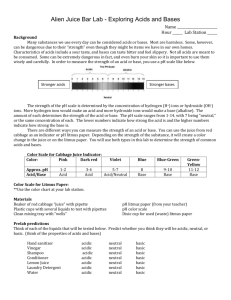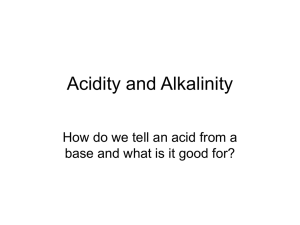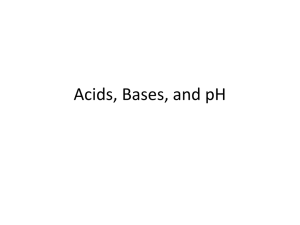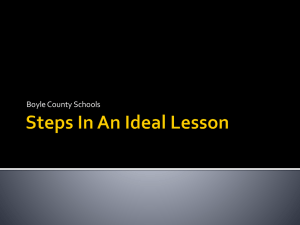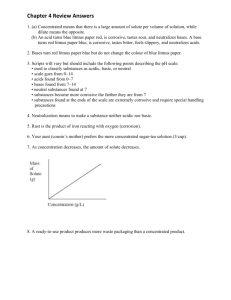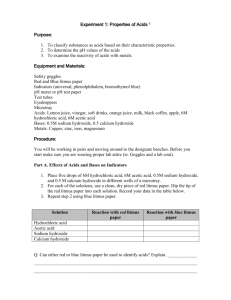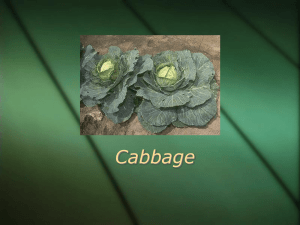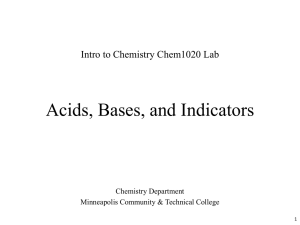Acids and Bases
advertisement
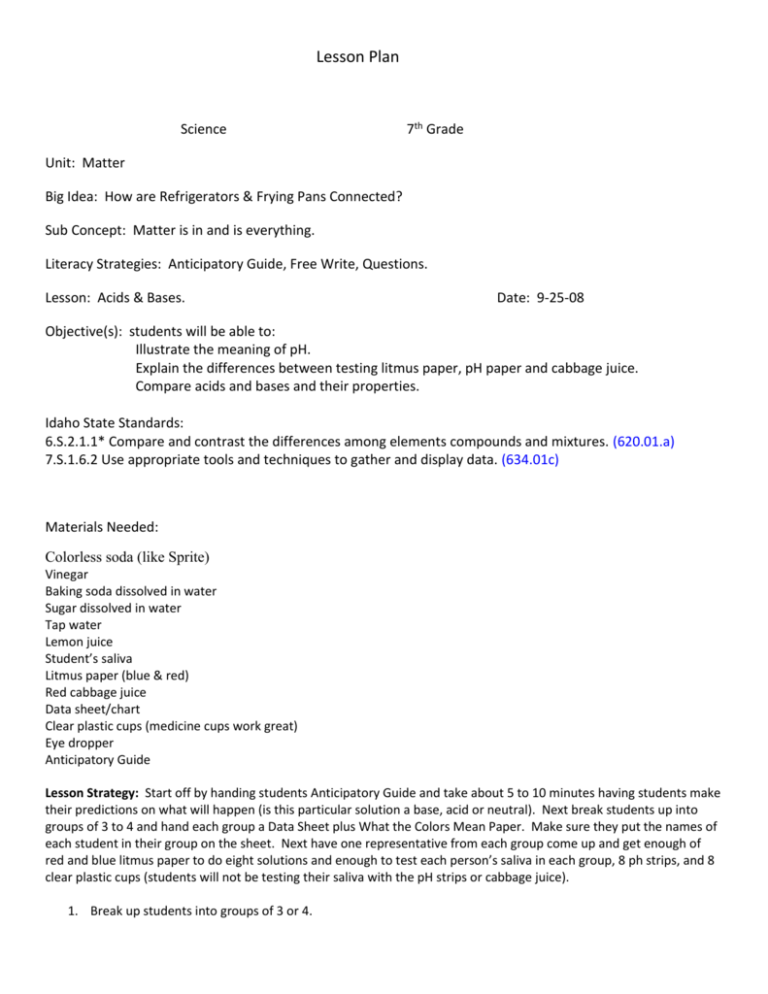
Lesson Plan Science 7th Grade Unit: Matter Big Idea: How are Refrigerators & Frying Pans Connected? Sub Concept: Matter is in and is everything. Literacy Strategies: Anticipatory Guide, Free Write, Questions. Lesson: Acids & Bases. Date: 9-25-08 Objective(s): students will be able to: Illustrate the meaning of pH. Explain the differences between testing litmus paper, pH paper and cabbage juice. Compare acids and bases and their properties. Idaho State Standards: 6.S.2.1.1* Compare and contrast the differences among elements compounds and mixtures. (620.01.a) 7.S.1.6.2 Use appropriate tools and techniques to gather and display data. (634.01c) Materials Needed: Colorless soda (like Sprite) Vinegar Baking soda dissolved in water Sugar dissolved in water Tap water Lemon juice Student’s saliva Litmus paper (blue & red) Red cabbage juice Data sheet/chart Clear plastic cups (medicine cups work great) Eye dropper Anticipatory Guide Lesson Strategy: Start off by handing students Anticipatory Guide and take about 5 to 10 minutes having students make their predictions on what will happen (is this particular solution a base, acid or neutral). Next break students up into groups of 3 to 4 and hand each group a Data Sheet plus What the Colors Mean Paper. Make sure they put the names of each student in their group on the sheet. Next have one representative from each group come up and get enough of red and blue litmus paper to do eight solutions and enough to test each person’s saliva in each group, 8 ph strips, and 8 clear plastic cups (students will not be testing their saliva with the pH strips or cabbage juice). 1. Break up students into groups of 3 or 4. 2. Have groups send a person to come and get 8 clear plastic cups, 8 pH strips, eye dropper, and enough red and blue litmus paper s, color sheet and data sheet per group. Eye dropper is important for testing the amounts of red cabbage juice and the solution. 3. Students place the end of a piece of both blue and red litmus paper into their mouths. 4. After five seconds, they take the papers out to see if either changed color (Red to blue, means a base; blue to red, means an acid, no change means neutral). Have students write this down the color next to their names on the data sheet in their groups. 5. Have students come up and get a sample of each solution in each cup. Should be enough solution in cups for end of pH strips to dip into. Have students dip the end of the pH strip into solution for 5 seconds then pull out and record color on data sheet. 6. Have students repeat step 5 until all solutions are tested and recorded. 7. Next have students dip ends of red and blue litmus papers into solution for 5 seconds and pull out and record the color on their data sheet. 8. Repeat step 7 until all solutions are tested and recorded. 9. Send a representative from each group to come up and get a cup of red cabbage juice and take back to their group. 10. Then have group with an eye dropper start dripping an equal amount of the cabbage juice into the solution until they see a color change then write that color down on data sheet. 11. Repeat step 10 until all solutions are tested and recorded. 12. Have students answer questions as a group on their data recorder sheet. 13. Hand back anticipatory guides so they can correct them and finish them. 14. After all students are done have each student write a 5 sentence paragraph on “what did I learn today that is important to me.” 15. Make sure students clean up their work area before they leave classroom. Anticipatory Guide pH & Bases Name____________________ Date_____________________ Directions: Predict whether each of the solutions/mixtures is a base or an acid in the first column. Then after lab check to see if your predictions were right and then support it with evidence from lab. Prediction before lab: Circle only one. Solution/Mixture Results after lab with supporting evidence. Base-Neutral-Acid Base-Neutral-Acid Your Saliva Evidence Base-Neutral-Acid Base-Neutral-Acid Vinegar Evidence Base-Neutral-Acid Base-Neutral-Acid Lemon Juice Evidence Base-Neutral-Acid Base-Neutral-Acid Tap Water Evidence Base-Neutral-Acid Base-Neutral-Acid Soda Evidence Base-Neutral-Acid Base-Neutral-Acid Sugar Water Evidence Base-Neutral-Acid Base-Neutral-Acid Ammonia Evidence Directions for lab: After all of you have turned in your anticipatory guides to me. 16. You will pick a person from your group to come and get 8 clear plastic cups, 8 pH strips, eye dropper, and enough 11 red and blue litmus papers, color sheet and data sheet per group. Eye dropper is important for testing the amounts of red cabbage juice and the solution. 17. Place the end of a piece of both blue and red litmus paper into each of your mouths when I say so. 18. After five seconds, they take the papers out to see if either changed color (Red to blue, means a base; blue to red, means an acid, no change means neutral). Write this down the color next to your names on the data sheet in their groups. 19. Next come and get a sample of a solution (enough to cover the tip of the pH strips). You will probably have to tip the cups as to get enough solution to cover it. Dip the end of one pH strip per solution and hold for 5 seconds then pull out and record the color. 20. Repeat step 4 until all solutions have been tested and recorded. 21. Next dip ends of red and blue litmus papers into solution for 5 seconds and pulls out and records the color on their data sheet. Note it doesn’t matter which you do first either the litmus paper or the pH strips as long as you record the results in the proper column. 22. Repeat step 6 until all solutions are tested and recorded. 23. Send a representative from each group to come up and get a cup of red cabbage juice and take back to your group. 24. With an eye dropper start dripping an equal amount of the cabbage juice into the solution until they see a color change then write that color down on data sheet. 25. Repeat step 9 until all solutions are tested and recorded. 26. Then answer questions 1-3 as a group on a separate sheet of paper. 27. Next I will hand back your anticipatory guides and allow you to finish them by using the evidence you collected as a group. NOTE: If you have any questions please ask before moving on. CABBAGE JUICE WILL STAIN YOUR CLOTHES! Red Cabbage Color Change & What It Means: Red/Pink Really acidic Pinkish Purple Slightly acidic Dark Purple Neutral (neither acidic or basic, like water) Blue Slightly basic Green/Yellow Really basic Litmus Paper Color & What It Means: Red litmus paper will turn slightly blue for a base. Blue litmus paper will turn slightly pink for an acid. No change means neutral. pH Strips Color & What It Means: Dark pink (red) means base. Orange to yellow means acidic. Yellow/Green means neutral Record Data Sheet Group Names______________________________ Directions: Fill in the chart with your findings from your lab. Then answer the questions fully. Saliva Litmus Paper Color/Acidic/Base/Neutral Name Name Name Solution Litmus Paper Color pH Strip Color Vinegar Lemon Juice Tap Water Soda Sugar Water Ammonia Now in your groups answer the following questions. 1. What solutions above are acidic, neutral and bases? 2. What are some other solutions mixtures that you would have liked to test? 3. What did you learn that you didn’t know before doing this experiment? Red Cabbage color LIMSST Project Literacy Lesson Reflection Form Name: Kevin Davis Lesson Title/Topic Areas: Date lesson was taught: 9/25/08 Acids & Bases Literacy Strategies Used: (Please discuss what literacy strategies you embedded in this lesson. What were your goals in using these strategies?) Anticipatory Guide, & Free write. My goals were to get the students more involved in their learning and be active participants and to get them to thinking about what I was trying to get them to learn. Student Response to the Lesson: (Was the strategy effective? Were students able to read/write as needed in this lesson? What attitudes were displayed? How did specific students and/or the class do? How did the literacy strategy aid in developing student understanding of the topic? Cite specific evidence from the samples of student work) I think that the students loved doing the Anticipatory Guide and really loved doing the free write at the end of the week. The Anticipatory Guides the students are now asking me to do them more often and the free writes they can’t wait till the end of the week o post those. That is when they get the chance to tell me how they felt the week went and what they liked and didn’t like about the lessons. I am seeing more and better writing in my class and I am also working with the Language Arts Teacher so that that Teacher can help me with getting better writing from students. Lesson Reflection: (What worked well with this lesson? What challenges did you encounter in this lesson? Would you change certain aspects of the lesson or the questions that you asked? How does this influence future lesson planning?) I thought the Anticipatory Guide worked well although I thought it was kind of hard for me to do. And not all of the students are on board in doing them. Some students didn’t like doing them. I am now getting more used to making them and the students are getting more used to doing them. I really like using the “Word Wall” also because this is where the students can be creative. Like anything though in teaching, it is a work in progress and I want to try and get students to really understand what they are learning and this takes time and practice. I am now introducing an Anticipatory Guide at least once a week and the Word Wall at least twice a month. The Free Write are weekly. In my Anticipatory Guides I’m working for the students to really search and find the evidence that supports or doesn’t support the statement. I am working on trying to incorporate more literacy strategies into my lessons. Relationship to Previous Instruction: (Have you taught this lesson/topic prior to the LIMSST project? If so, how did your teaching of this lesson differ from what you taught before? How did students’ reactions to this lesson differ?) Yes, and I have found that teaching the way I did this year was way different from how I previously taught it. I would generally just have the students do the lab and then answer the questions after the lab. With the Literacy Strategies I found that the students are more interested in te subject matter and that they are learning more. They are now writing more and thinking more broadly instead of just answering the questions just to get them done. They seem to be more interested in the subject matter and are doing better on their tests.
